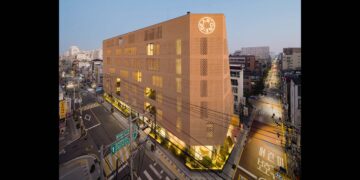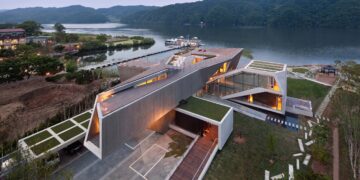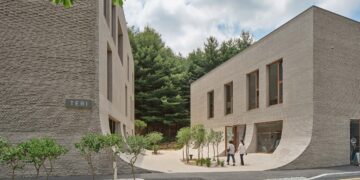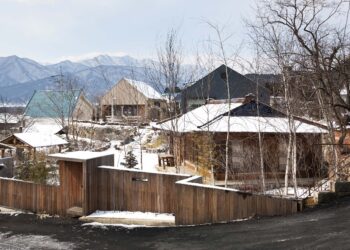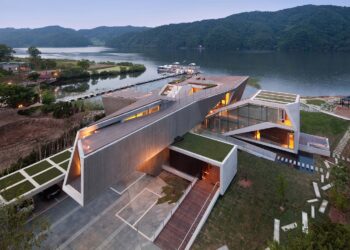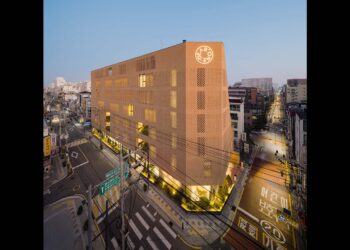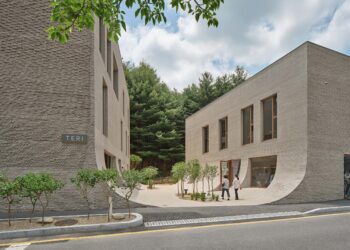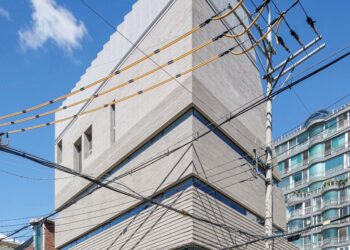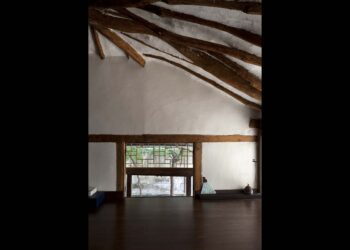Gongbech_Untouchable Heart


The coastline of Jeju Islands, low and densely covered with basalt, meets the eye. Beyond the seaweed-covered black stones scattered like patches of moss, the sea of Jeju lies lower and quieter. The landscape, untouched and raw, with sparsely populated tranquility, walks along the surface, low and peaceful. Nonchalantly taking its place, it effortlessly enters two buildings that, similarly, appear untouched and raw, just like the surroundings. Though vastly different entities – one being a natural sea and the other an artificial structure on land – the emotions conveyed between them seem remarkably similar, as if they have deliberately imitated each other over the years.





The buildings are located at the edge of a village on the northeast coast of Jeju. Two warehouses sit on a hill where trees and grass grow leaning toward the land in the harsh sea breeze. These buildings, constructed as frozen storage in 1982, exude the silence and rough disorder characteristic of long-abandoned ruins. The regenerated space actively preserves rather than erases the essence of that emotion. In this regard, the narrative attitude encapsulated in the space is clear. The past’s neglected sense of place, now in ruins, encounters the present.
The beginning of the project inevitably involved demolition. Through the unavoidable considerations of “what to keep and what to create a new,” the space retains the overwhelming sense of space provided by the building’s size and the regular repetition of the rammed earth structure that intensifies it. The newly created void, as wide as the building’s length, opens up low and continuous openings, allowing one to encounter the horizontal line of the Jeju sea and the coastal landscape from any vantage point. The high openings at the front of the space also capture the sky of Jeju. The same order is imposed on the second building as well.





The scattered partition walls inside the space are treated like commemorative sculptures honoring the past. The roof trusses and the perforated slate roof, spaced at 2m, are preserved as they are. The tree growing through the cement floor, puncturing it, also occupies its place as an object symbolizing the sense of place. The program within the space includes a multi-cultural facility, including a casual dining restaurant. The multipurpose space capable of hosting various cultural events, functioning as a gallery, is likely to offer a fresh impact and ripple effect before unveiling the artworks. Occasionally being captivated by Jeju’s rain, wind, light, and the distant sound of waves, along with the chic and modern sense emerging from the silence of ruins, seems more than enough.







Project: GONGBECH_UNTOUCHABLE HEART / Location: 85, Dongbok-ro, Gujwa-eup, Jeju-si, Jeju-do, Republic of Korea / Architect: SF LAB / Lead Architect: Moo Gyu Choi / Design team: Haechul Shin / Collaborators: Media art: teamVOID (Song Junbong, Bae Jaehyuck, Seok Booyoung), Audio system: ODE (DI Corp.) / Landscape architect: Masilnuri (Sangsoo An) / Contractor: EWAI Corp. (Park Gwangock, You Jedong) / Client: GONGBECH Corp. / Use: Neighborhood living facilities (cafes and galleries) / Site area: 5,071m² / Bldg. area: 1,592.93m² / Gross floor area: 1,731.17m² / Bldg. scale: one story below ground, one story above ground (four buildings) / Structure: reinforced concrete / Finishing: S.ST.316/304, epoxy-based terrazzo, reflective film, tempered glass / Completion: 2019 / Photograph: ©Kyung Noh (courtesy of the architect)

[powerkit_separator style=”double” height=”5″]






